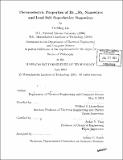Thermoelectric properties of Bi₁â‚‹x̳Sbx̳ nanowires and lead salt superlattice nanowires
Author(s)
Lin, Yu-Ming, 1974-
DownloadFull printable version (13.21Mb)
Other Contributors
Massachusetts Institute of Technology. Dept. of Electrical Engineering and Computer Science.
Advisor
Mildred S. Dresselhaus and Jackie Y. Ying.
Terms of use
Metadata
Show full item recordAbstract
This thesis involves an extensive experimental and theoretical study of the thermoelectric-related transport properties of BilxSbx nanowires, and presents a theoretical framework for predicting the electrical properties of superlattice nanowires. A template-assisted fabrication scheme is employed to synthesize Bi-based nanowires by pressure injecting liquid metal alloys into the hexagonally packed cylindrical pores of anodic alumina. These nanowires possess a very high crystalline quality with a diameter-dependent crystallographic orientation along the wire axis. A theoretical model for Bil-Sbx nanowires is developed, taking into consideration the effects of cylindrical wire boundary, multiple and anisotropic carrier pockets, and non-parabolic dispersion relations. A unique semimetal-semiconductor (SM-SC) transition is predicted for these nanowires as the wire diameter decreases or as the Sb concentration increases. Also, an unusual physical phenomenon involving a very high hole density of states due to the coalescence of 10 hole carrier pockets, which is especially advantageous for improving the thermoelectric performance of p-type materials, is uncovered for BilxSbx nanowires. Various transport measurements are reported for Bi-related nanowire arrays as a function of temperature, wire diameter, Sb content, and magnetic field. R(T) measurements show distinct T dependences for semimetallic and semiconducting nanowires, as predicted by the theory, and the condition for the SM-SC transition can be clearly identified. Enhanced thermopower is observed for BilxSbx nanowires as the diameter decreases or as the Sb content increases, indicating that both quantum confinement effects and Sb alloying effects are important for improving the thermo-electric performance. (cont.) The theoretical model is further extended to study transport properties of Te-doped Bi nanowires and Sb nanowires, and good agreement between theoretical predictions and experimental results is obtained. A model for superlattice nanowires is presented to evaluate their potential for thermoelectric applications. Thermoelectric properties of superlattice nanowires made of various lead salts (PbS, PbSe, and PbTe) are investigated as a function of segment length, wire diameter, crystal orientation along the wire axis, and length ratio of the constituent nanodots. An interesting inversion of the potential barrier and well induced by quantum confinement is predicted in superlattice nanowires as the wire diameter decreases. ZT values higher than 4 and 6 are predicted for 5 nm-diameter PbSe/PbS and PbTe/PbSe superlattice nanowires, respectively, at 77K, and these ZT values are significantly larger than those of their corresponding alloy nanowires. For a given superlattice period, the ZT value can be further improved by adopting different segment lengths for the two constituent materials. The model developed here not only can determine the optimal superlattice nanowire parameters (segment length, diameter, materials, and doping level) for thermoelectric applications, but also can be extended to other superlattice systems, such as 3D quantum dot arrays ...
Description
Thesis (Ph. D.)--Massachusetts Institute of Technology, Dept. of Electrical Engineering and Computer Science, 2003. In title on t.p., double-underscored "x" appears as subscript. Includes bibliographical references (p. 138-147).
Date issued
2003Department
Massachusetts Institute of Technology. Department of Electrical Engineering and Computer SciencePublisher
Massachusetts Institute of Technology
Keywords
Electrical Engineering and Computer Science.